For years I sped through Yoho National Park on Highway 1, in a hurry to get to Banff. From the road, the mountains were pretty but they didn’t entice me to stop. Oh how wrong I was! Once I finally got off the highway and saw all the things to do in Yoho National Park, I was hooked.
On my first trip to Yoho, we drove up the narrow and winding Yoho Valley Road into the mountains. I was shocked when Takakkaw Falls came into sight – I couldn’t believe how tall it was. On later trips, I discovered more waterfalls, incredible blue glacial lakes, towering peaks, clean campgrounds, and well-signed hiking trails.
I keep coming back to Yoho over and over because it has so much to offer. I think I’ve been to Yoho four times in the past five years. Yes, it’s an easy pit stop on the drive to Banff. But I think Yoho really deserves more of your time.
I’ve put together a complete guide to things to do in Yoho National Park. It includes:
- Yoho National Park Basics: How to get there? How long to spend? Plus Parks Pass info, cell service, and more.
- Map of Yoho National Park that includes all of the places I mention in this post.
- Best things to do in Yoho: Waterfalls, glacier lakes, viewpoints, hiking trails, fossils, history, and more.
- Where to stay in Yoho from basic campsites to luxury hotels and everything in between.
This is a sensitive wilderness area. Learn how to Leave No Trace to keep the wilderness wild. Make sure you are prepared by bringing the 10 Essentials. Get ready for adventure with this checklist of things to do before every hike.
Hey there: Some of the links in this post are affiliate links, which means I earn a small commission at no cost to you. Thanks for your support. -Taryn
Yoho National Park Basics
Location
Yoho National Park is located in the Canadian Rockies. The park is about 1 hour west of the town of Banff, Alberta and 45 minutes east of the town of Golden, BC. The small town of Field is located inside the park. The park borders Banff National Park to the north and east and Kootenay National Park to the south.
How to Get to Yoho National Park
The closest airport to Yoho National Park is Calgary International Airport, which is a 2.5-hour drive away. It is possible to take a shuttle bus to the nearby town of Banff, about 1 hour away. However, there is no public transportation to the park – you will need to drive yourself or book a tour.
Getting Around in Yoho National Park
Unlike nearby Banff National Park, there is no public transportation in Yoho. The park is spread out along 60 kilometres of Highway 1 and several side roads. You will need to have your own car or join a tour group.
It’s easy to join a day tour leaving from Banff that hits Yoho’s highlights. This top-rated 8-hour tour visits Emerald Lake and Natural Bridge in Yoho along with Lake Louise and Moraine Lake in Banff. If you want to focus on Yoho, this popular Yoho National Park tour visits Emerald Lake, Takakkaw Falls, Natural Bridge, and the Spiral Tunnels viewpoint.
The easiest place to rent a car is in Calgary, but you can also rent a car in Banff. I use DiscoverCars to book rental cars since it lets you compare prices across rental companies.
Keep in mind that Emerald Lake and Takakkaw Falls (the most popular parts of the park) will be very busy in July and August. It can be impossible to find parking if you arrive in the middle of the day. Plan to arrive in the morning or early evening.
Yoho National Park Passes
You must purchase a Parks Canada pass to stop anywhere in Yoho National Park. Buy them at the Yoho Visitor Centre in Field, either at the desk or from the machine in the parking lot. You can also buy a Parks Canada Pass at the entrance gates to Banff National Park – the same pass is valid for Banff, Yoho, and Kootenay National Parks.
Parks passes cost $11/day for adults or $9.50 for seniors. Kids are free. The best deal is the family/group pass for $22/day which covers up to seven people travelling in the same vehicle.
If you plan to visit other Canadian National Parks in the same year or your trip is longer than one week, it’s worth buying a Parks Canada Discovery Pass which is valid at all National Parks for a full year. They cost $75.25/adult, $64.50/senior, or $151.25 for a group of up to 7 people in the same vehicle.
You will need to display your park pass on the dash of your car whenever you are parked in the park.
Cell Service in Yoho National Park
Most of the park doesn’t have cell service. There is reliable cell service in the town of Field and for a few kilometres of highway on either side. But otherwise, expect to be out of service. Download offline maps ahead of time.
How Long to Spend in Yoho National Park
If you don’t plan to do any hiking, it’s possible to see the park highlights like Emerald Lake and Takakkaw Falls in . You can visit Yoho as a day trip from Banff, and that’s a popular way to do it.
However, I think that Yoho has a lot to offer on its own and is worth a bit more time. I recommend spending at least two or three days in Yoho so you can explore at a slower pace and go on some hikes.
Best Time to Go to Yoho National Park
Since it is high in the mountains, Yoho National Park gets a lot of snow. The best time to visit the park is between July and mid-September. At that time of year, the park will be snow-free and all trails will be open. However, it’s worth checking trail conditions on the Yoho National Park page before you go.
Yoho National Park Weather
Yoho National Park has fickle mountain weather. In July and August, the average high temperature is 22°C and the average low is 5°C. Expect rain and clouds at any time – pack a rain jacket just in case. Use my picks for the Best Weather Apps for Hiking to see the forecast for your trip.
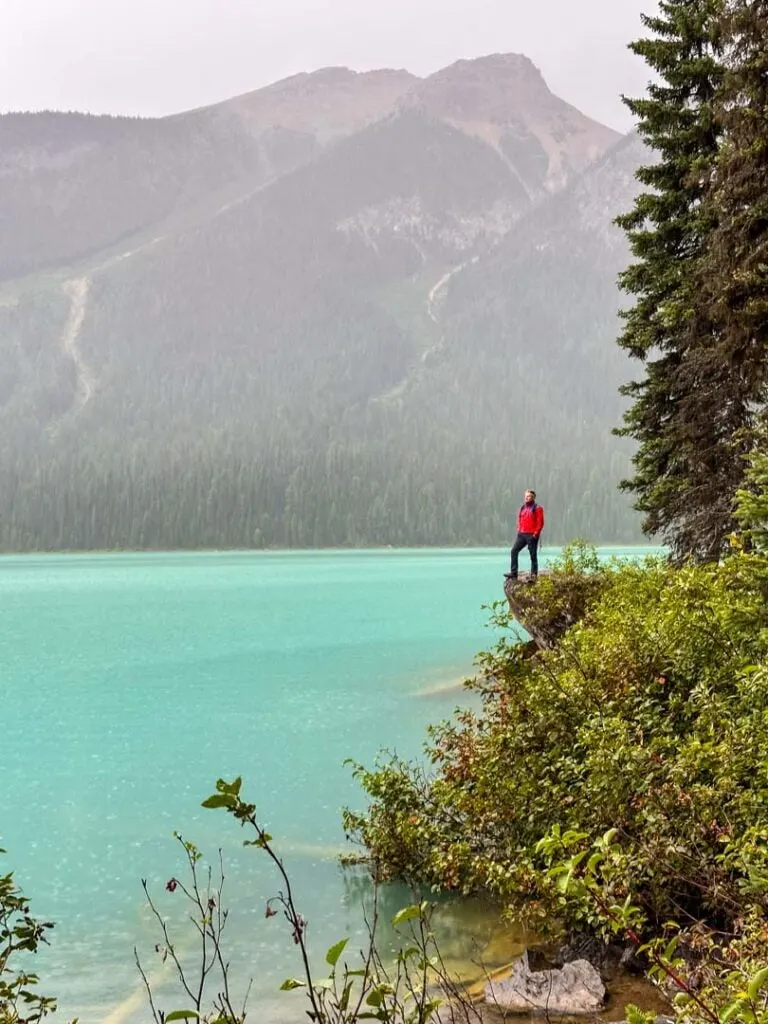
Groceries and Supplies in Yoho National Park
The town of Field is located inside the park. It has a gas station, two restaurants, and several guesthouses. However, it does not have a grocery store. The closest grocery stores are in Lake Louise, (25 minutes east), Banff (1 hour east), and Golden (45 minutes west).
Wildlife in Yoho National Park
Yoho National Park is in bear country (both black bears and grizzly bears). Carry bear spray, hike in a group, and make noise, especially in brushy areas. Keep your dog on a leash. Read my bear safety tips for hikers for more info.
You can also spot many other animals in the park including elk, moose, deer, mountain goats, big horn sheep, porcupines, pikas, and marmots. You will probably also see both Columbian and golden-mantled ground squirrels. Both species love to hang out at viewpoints begging for food from tourists. But please don’t give in – it’s terrible for their health and makes them aggressive.
Yoho National Park Map
To help you find your way around, I made this custom Google Map of Yoho National Park for you. It includes every single place I mention in this post. Keep in mind that there is no cell service in most of the park so you will need to download offline maps before you go.
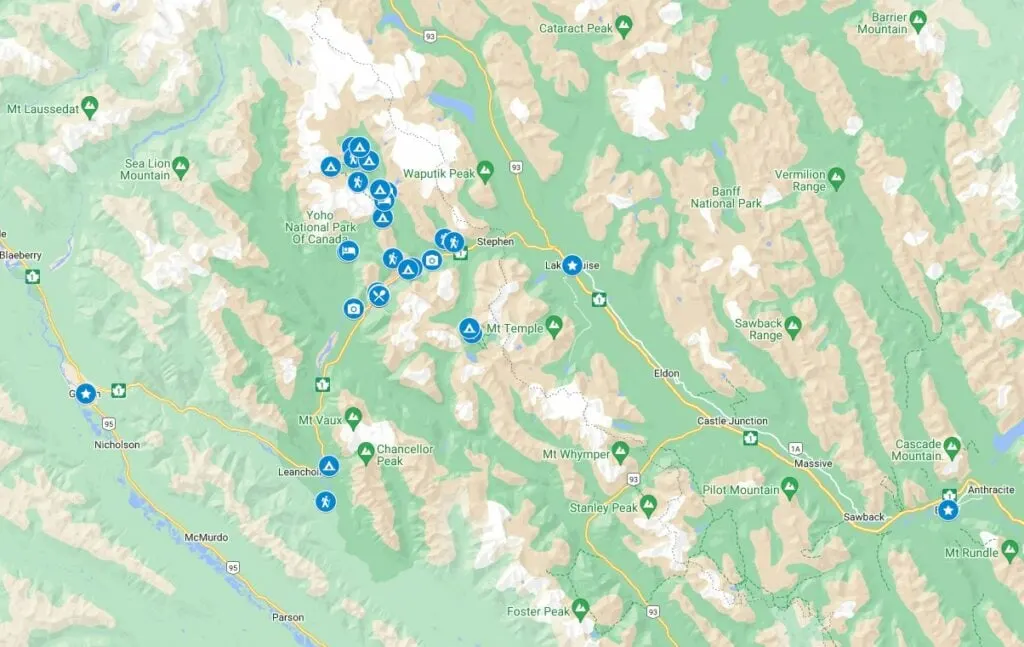
If you’re looking for a paper map, I recommend the Lake Louise and Yoho Map by Gem Trek Maps. It’s a waterproof map that shows all of the park trails, roads, and points of interest.
Things to Do in Yoho National Park
Yoho National Park Visitor Centre
The best place to start your trip is the Yoho National Park Visitor Centre. It is located at the entrance to the town of Field just off Highway 1. You can take a few minutes to explore the exhibits, and then ask staff questions to help plan your stay.
The Visitor Centre is also home to the Friends of Yoho National Park gift shop. This is by far the best official gift shop at any of the Canadian Rocky Mountain Parks. They have a good selection of t-shirts, hats, stickers, and other souvenirs. They also have an incredible book section with hiking books, nature field guides, history books, biographies, and more. I buy one almost every time I visit.
It’s also quite practical to visit the Visitor Centre. It has flush toilets and reliable cell phone service. You can also buy your park admission pass here, either at the desk when the centre is open or at the vending machine outside at any time.
Emerald Lake
With an amphitheatre of mountains and turquoise blue waters, Emerald Lake is so beautiful that it rivals the scenery at Lake Louise. Emerald Lake is the most popular attraction in Yoho National Park, so you will still find full parking lots and lots of people. But it attracts a fraction of the tourists that Lake Louise does, so it feels a bit more serene.
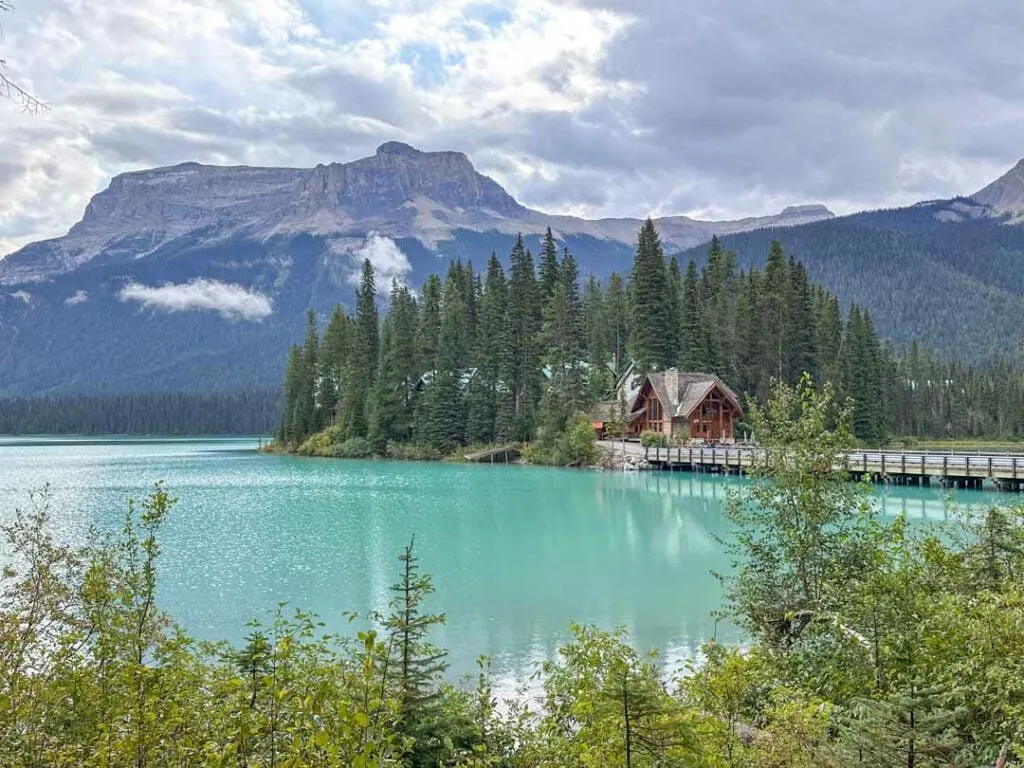
The only way to get to Emerald Lake is to drive the nine-kilometre-long Emerald Lake Road, which leaves Highway 1 3 km west of Field. The road ends at a medium-sized parking area, which fills up by mid-morning. Plan to arrive early or come late in the day.
Once you arrive, wander down to the lakeshore to enjoy the scenery and take some photos. The area around the Emerald Lake Lodge has the best views.
You can also rent a canoe at the boathouse to paddle around the lake. While canoe rental prices are cheaper than at Lake Louise or Moraine Lake, it’s still really expensive. As of 2024, it is $100 per hour! You aren’t allowed to bring your own canoe, kayak, SUP, etc. to Emerald Lake because of the risk of whirling disease.
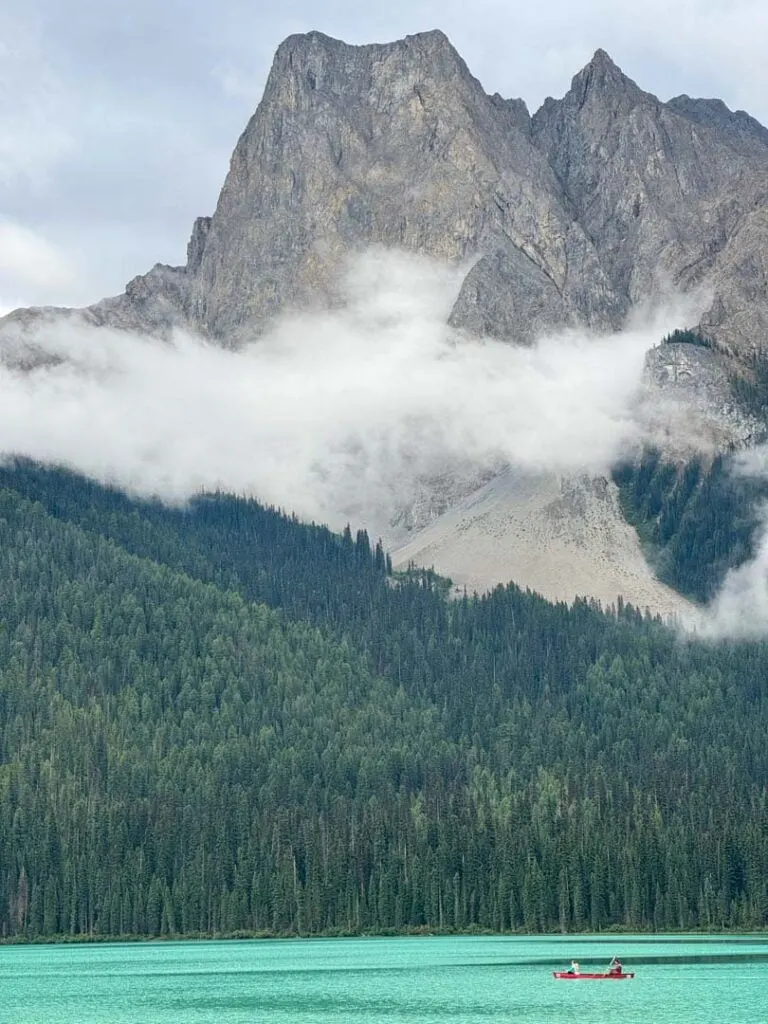
If you are up for a hike, you can follow the 5.2-km-long Emerald Lake Trail around the lake. The western half is easy and flat, but the eastern and southern sections are rooty and muddy. Allow about 2 hours for the full loop. There are also several challenging hiking trails leading up into the mountains around the lake.
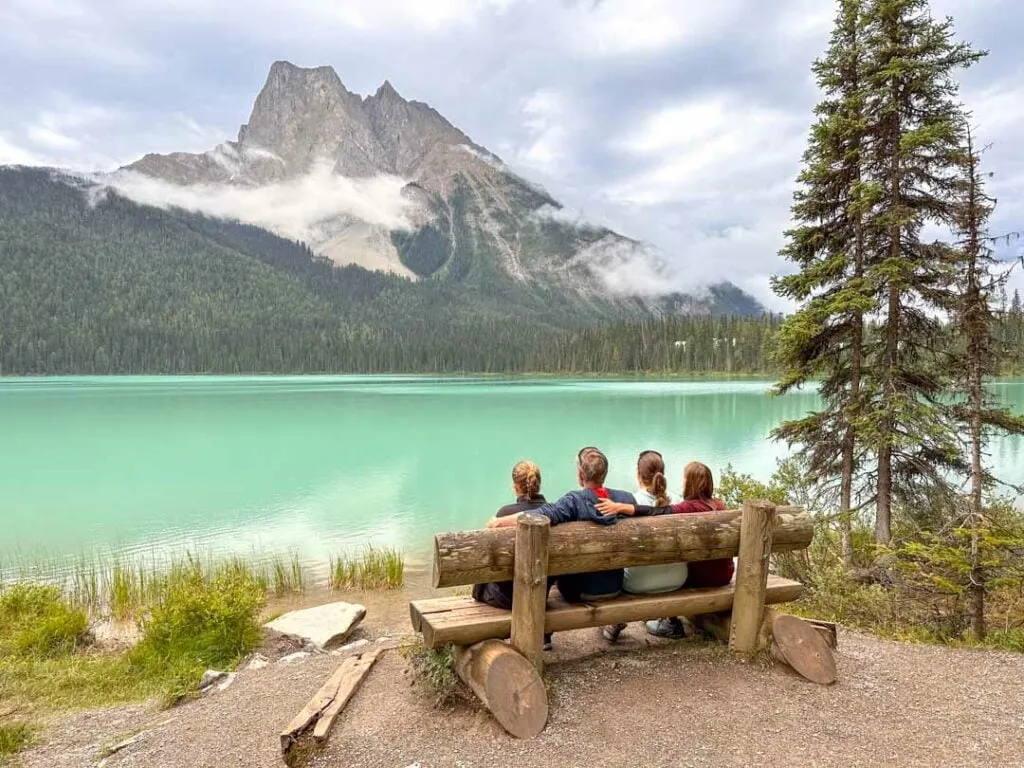
If you’re hungry, you can eat at one of the restaurants at the Emerald Lake Lodge. Cilantro on the Lake is the most informal, but it’s still on the pricey side.
Natural Bridge
If you’re driving the Emerald Lake Road, don’t miss stopping at Natural Bridge on your way to or from the lake. The Kicking Horse River has eroded the rocks and rushing waters go through a natural stone bridge. From the small parking lot, you can follow paths to several viewpoints on both sides of the river.
This is one of my favourite spots in Yoho since it is such a cool feature. The river is constantly carving out a canyon. Originally, the river would have run over rocks to create a waterfall. But instead, it wore a hole through the rocks, creating a fissure that the water flows through.
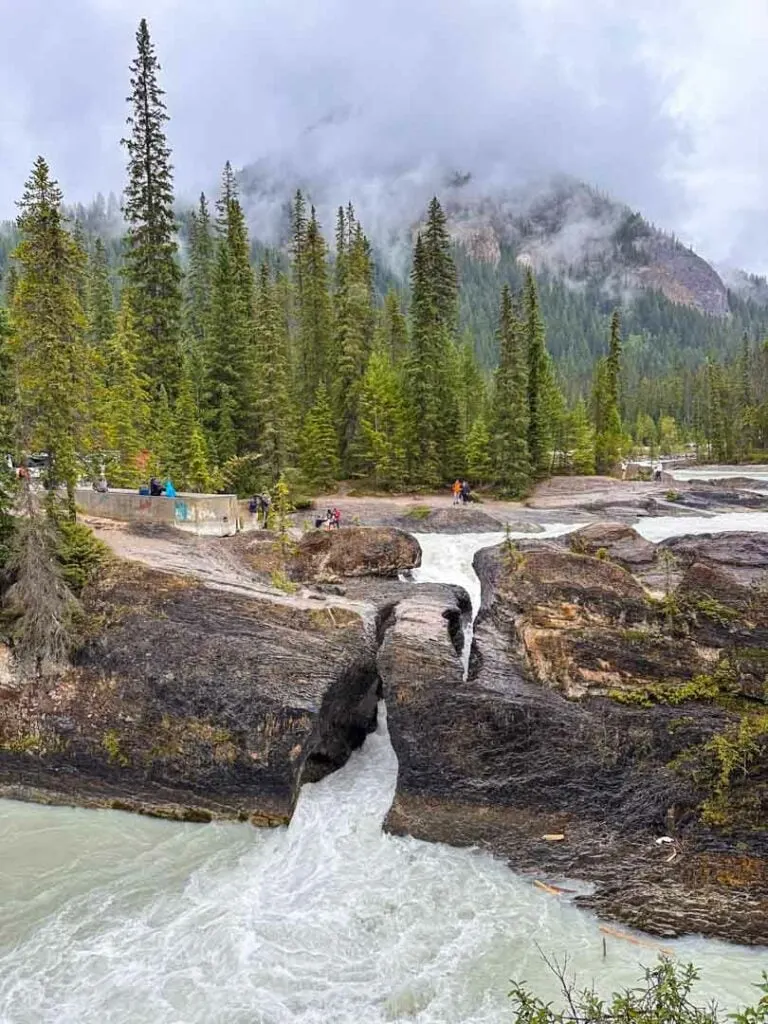
Takakkaw Falls
Besides Emerald Lake, Takakkaw Falls is probably the second-most visited spot in Yoho National Park. At 373 metres, it is one of the tallest waterfalls in Canada. (However, it is shorter than Della Falls on Vancouver Island.)
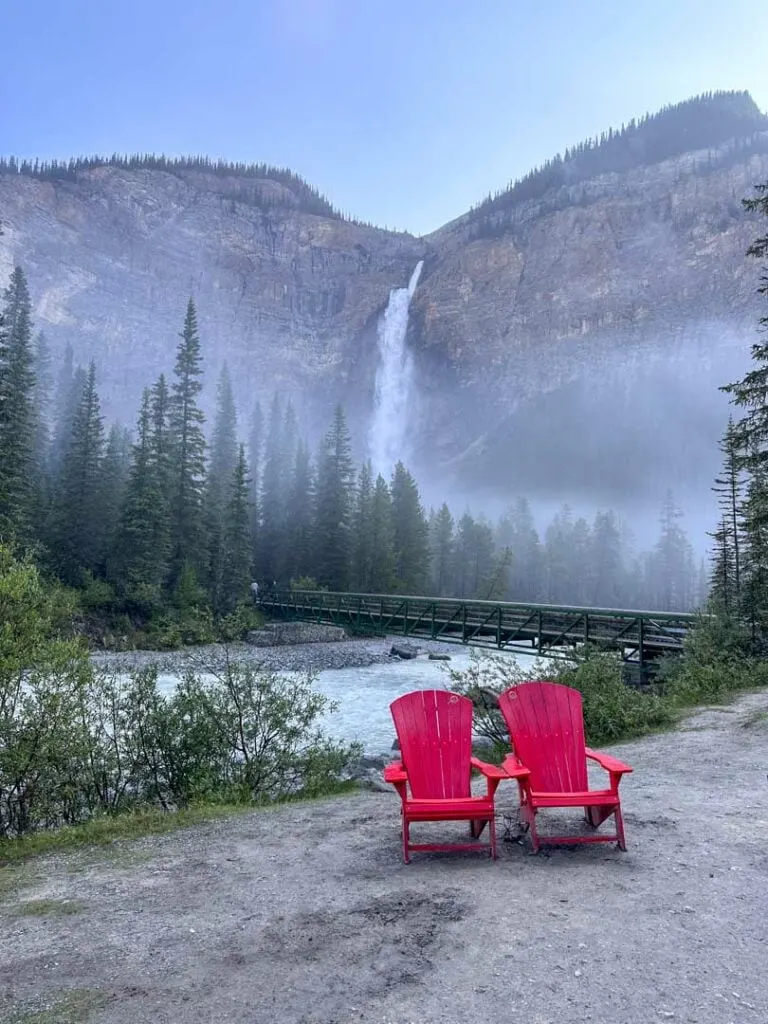
The easy walk to the falls is about 0.7 km each way. You’ll get great views of the falls along the trail as you get closer and closer. You may want to bring a rain jacket because the spray from the falls creates mist in the air that gets wetter and wetter the closer you get to the base of the falls.
The falls are at their fullest in June during the snowmelt, but they are still spectacular later in the summer and early fall.
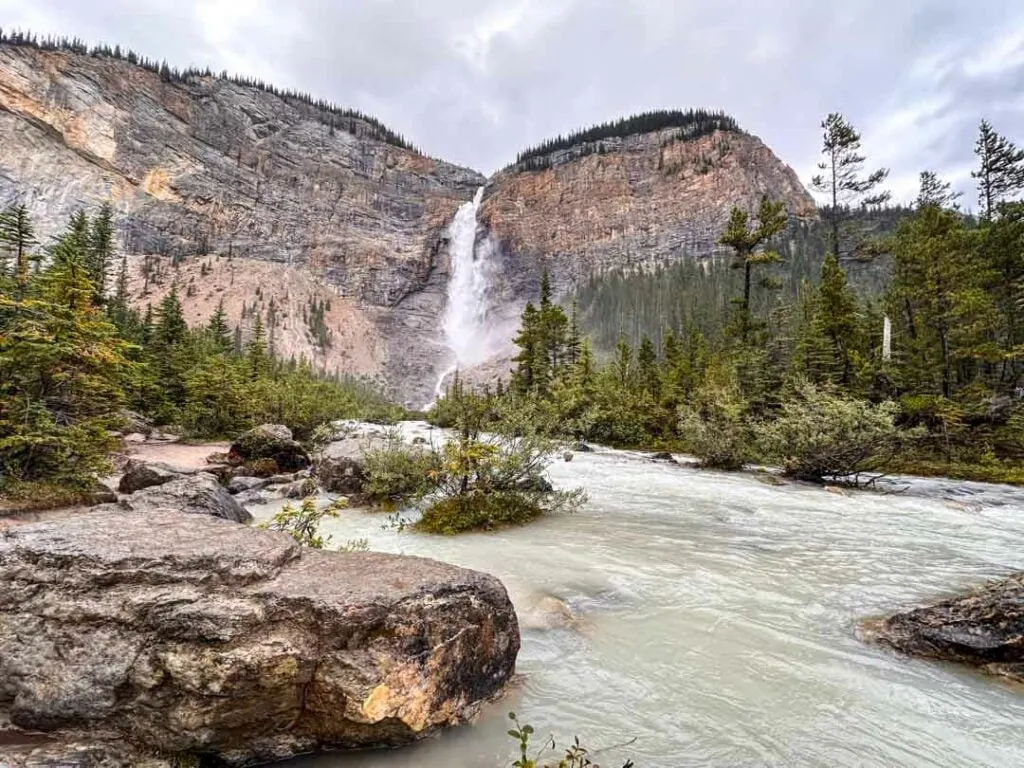
The parking lot for Takakkaw Falls is located at the end of Yoho Valley Road, which is 13 km long. The road is closed due to avalanche danger between early October and mid-June. The road has several sharp switchbacks. Trailers are not allowed and vehicles over 7 metres (23 feet) may have to back up and do a multi-point turn to get around the corners.
The parking lot fills up by mid-morning. Go early or late in the day for the best chance of getting a parking spot.
Lake O’Hara
Lake O’Hara is a special place. It’s a glacier lake surrounded by towering mountains and garlanded with some of the best hiking trails in the Canadian Rockies. I’ve been there twice and I think it should be on every hiker’s bucket list… but there’s a catch.
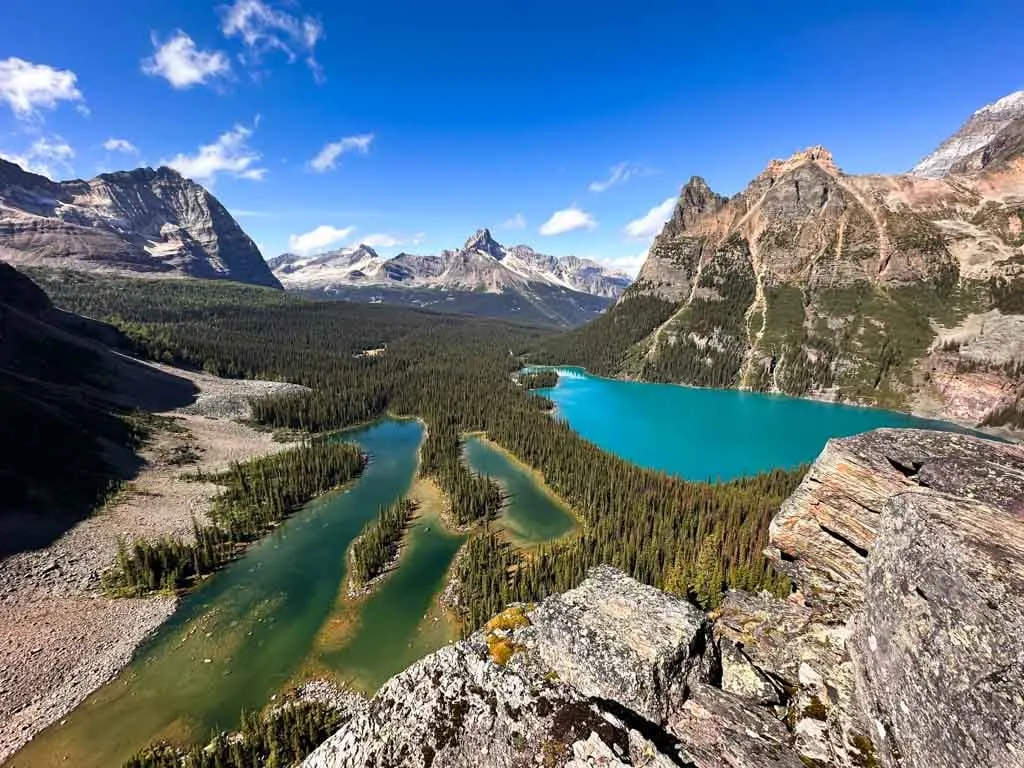
The only way to get to the lake is via an 11-km-long gated road. You can book tickets on a shuttle bus that goes to the lake a few times a day, but it’s so popular that there is an annual lottery for tickets. You can also walk up the road to the lake, but that takes a few hours and gives you less time to hike at the lake.
Psst: If you didn’t get a ticket, I recommend signing up for Schnerp or Campnab. They will send you a text if a cancellation opens up so you can book it right away. My guide to Campnab and Schnerp has all the details.
Once you arrive at the lake, there are lots of gorgeous hiking options. The most popular choice is the Lake O’Hara Alpine Circuit. This challenging loop links together paths along ledges high above the lake for some of the most breathtaking views you’ll ever see.
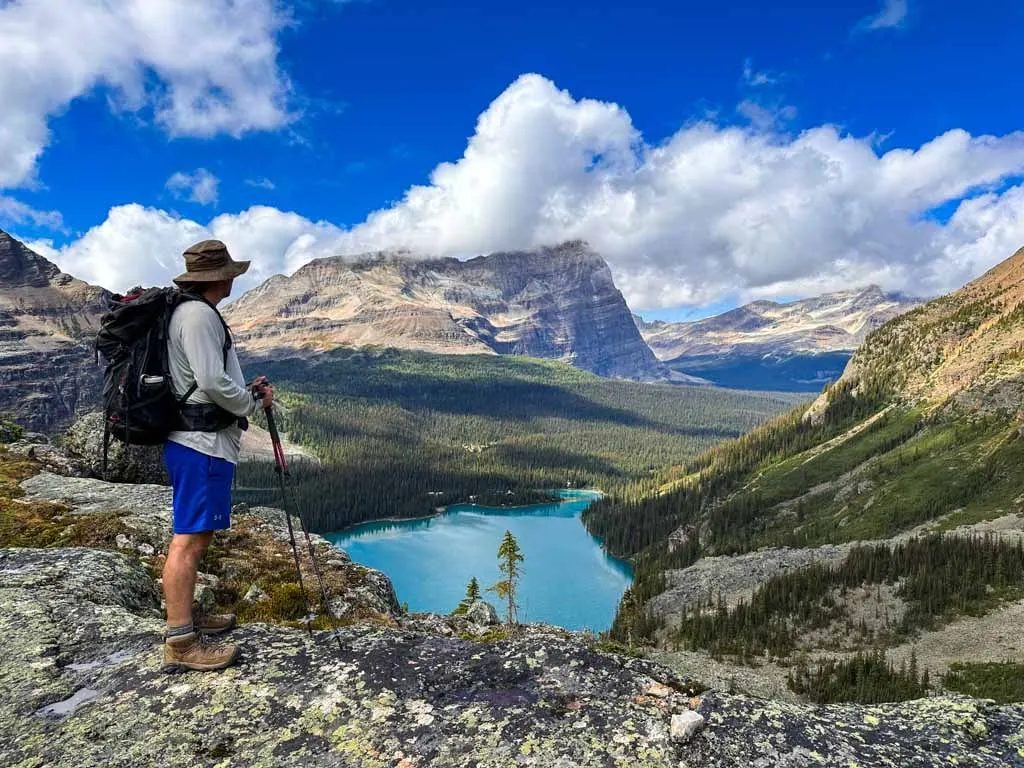
Other beautiful hikes include Opabin Prospect, Lake Oesa, and Lake McArthur as well as the easy trail along the perimeter of Lake O’Hara.

If you want to extend your visit, you can book a room at the luxury Lake O’Hara Lodge, a bunk at the rustic Elizabeth Parker Hut, or a campsite at the Lake O’Hara campground. However, all three options are very hard to book.
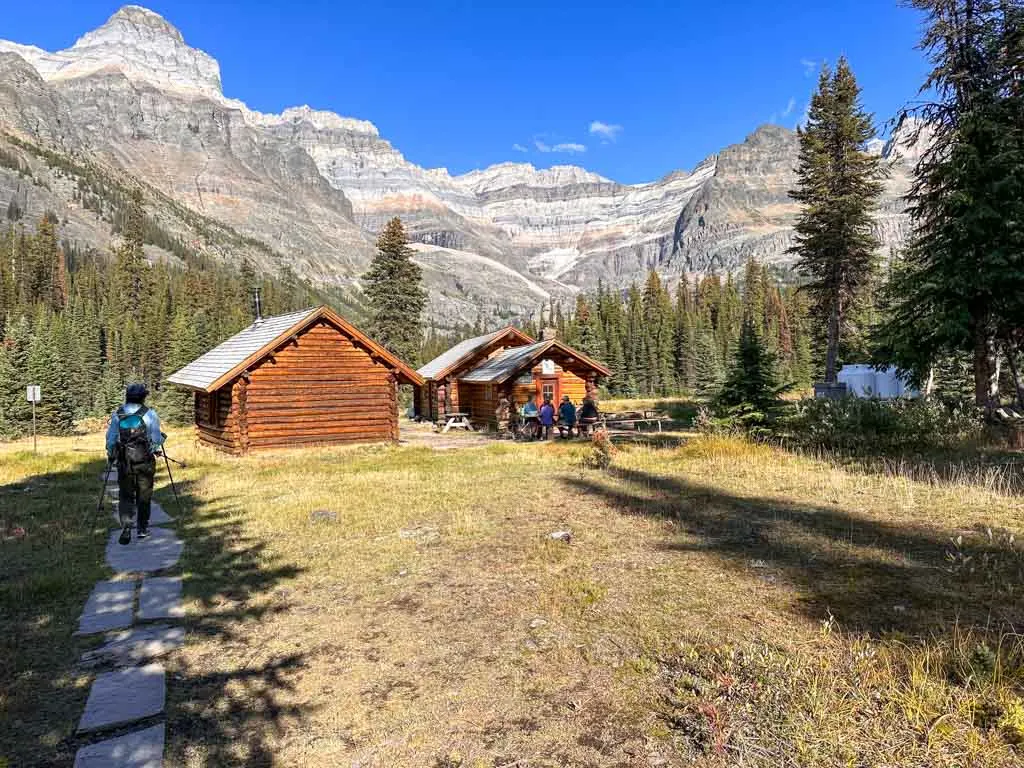
Visiting Lake O’Hara can be a bit complicated, so I’ve got a complete Lake O’Hara guide to explain it all. I also run the Lake O’Hara Facebook group, which is a great place to check trail conditions and read reports from other visitors.
Burgess Shale Fossils
Even if you aren’t into fossils, you’ll find the Burgess Shale fascinating. The mountains of Yoho National Park have a unique layer of shale rocks that holds fossils from 508 million years ago. It’s one of the oldest fossil beds in the world to preserve the soft bodies of organisms, not just their bones and teeth.
The fossilized creatures look fantastical – they have tons of legs, antennae, and strangely shaped bodies. And since they are so well preserved, you can see their eyes, brains, guts, and more.
There are several ways to see the Burgess Shale fossils in Yoho National Park. The easiest one is to visit the Burgess Shale exhibit at the Yoho Visitor Centre.
It’s also possible to see the fossils in situ in the mountains, however, the fossil sites are closed to the public so the only way to visit is on a guided hike. The hikes are run by Parks Canada and the Burgess Shale Geoscience Foundation and you must reserve in advance. Reservations open in late January each year, but they don’t sell out right away.
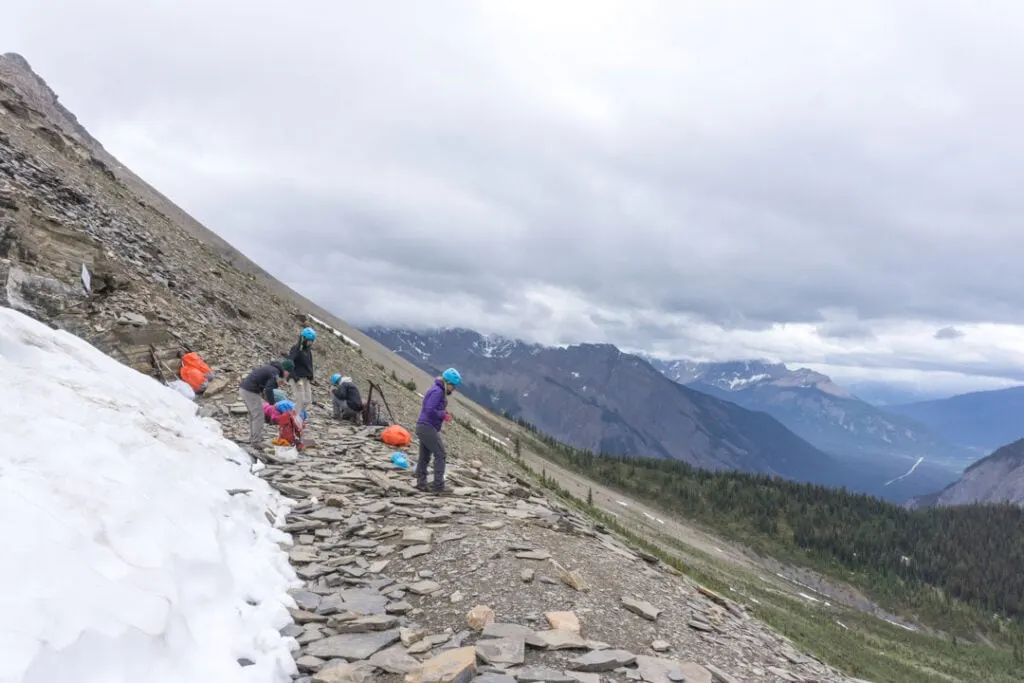
There are three different guided hikes to choose from: a shorter one rated moderate and two longer ones rated difficult. I did the most difficult one to Walcott Quarry a few years ago. It was a tough hike but parts of it had great views. Visiting the fossil quarry was really cool and we got to see lots of interesting fossils. Our guide also spent lots of time explaining the geology of the fossil beds and the local mountains.
Town of Field
The tiny town of Field is a stark contrast to the hustle and bustle of Banff. While the town used to have a larger population, today it’s home to less than 200 people. The town was built to serve the railroad and several mines which have long since closed.
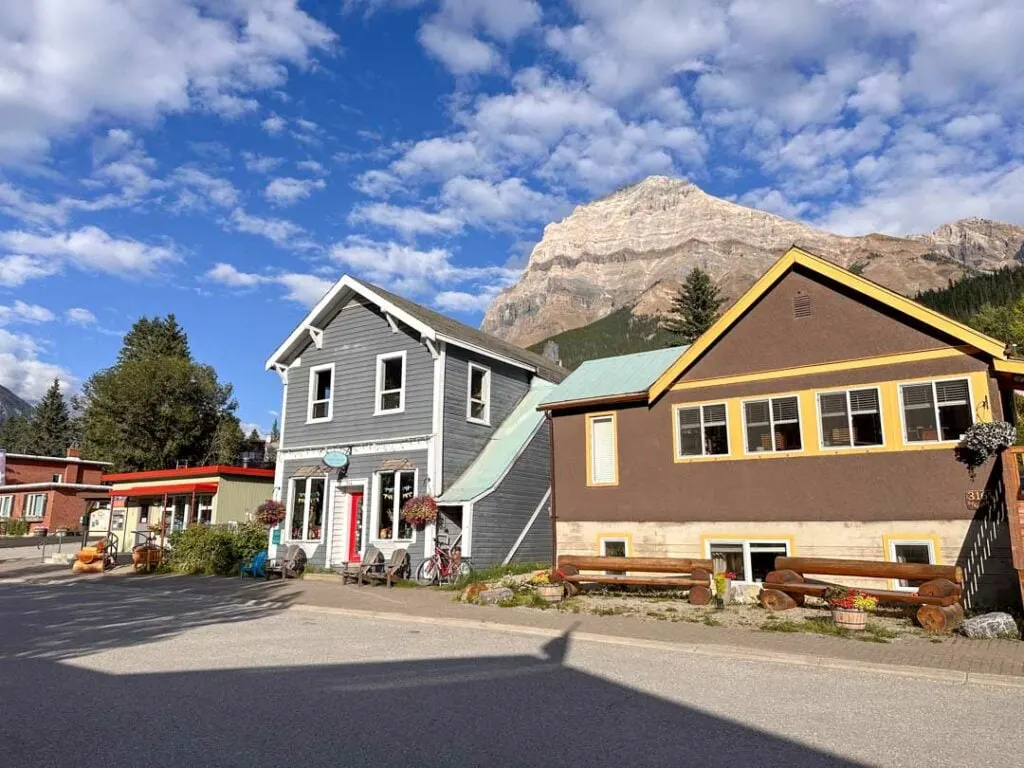
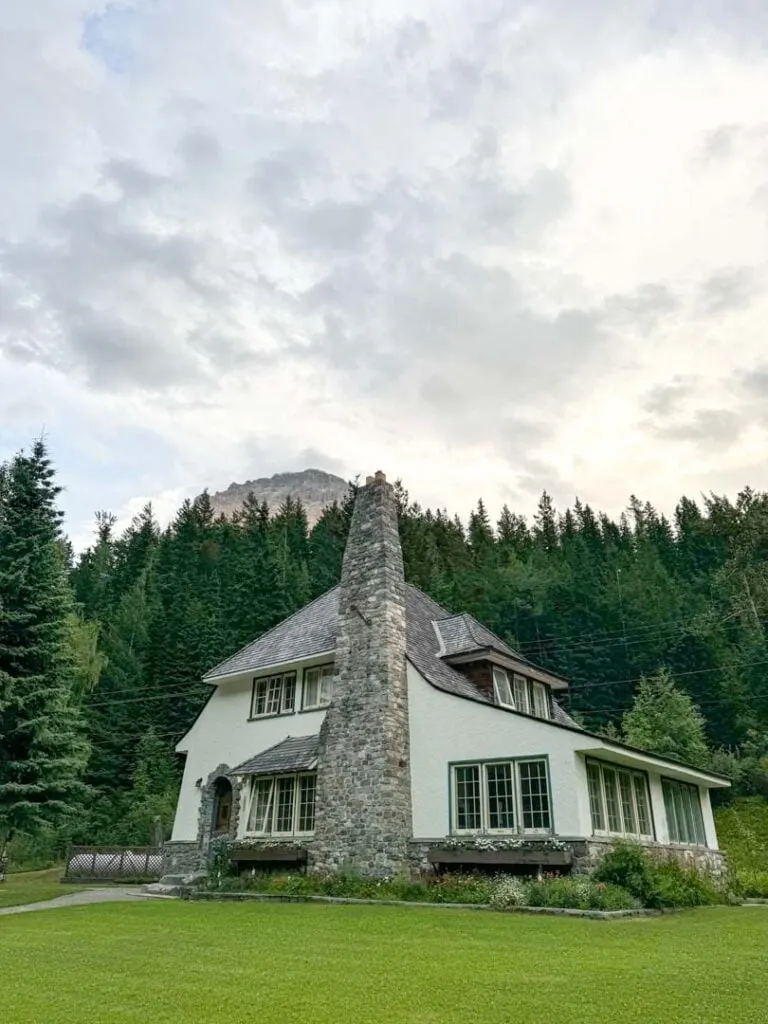
It’s worth stopping in Field to wander around and look at some of the historic buildings. If you want the inside scoop, I really recommend the historic walking tours of town. Volunteers from the Friends of Yoho National Park lead the tours every Tuesday and Thursday night during the summer. Tours are free, but donations to Friends of Yoho are appreciated.
I was lucky enough to have Michale Lang, the former curator of the Whyte Museum in Banff as my guide. She told us lots of great stories about the history of Field. Instead of just a repetition of dates and events, she told us stories about the town’s residents through time.
Field is also a great place to stop for food. The town has two restaurants. The Siding Cafe is an informal lunch spot serving sandwiches and coffee. Unfortunately, they don’t have much indoor seating, so on rainy days you might have to get takeout. The other option is Truffle Pigs Bistro, which is a bit more high-end but gets great reviews. It doesn’t take reservations, so unfortunately, I wasn’t able to eat there. Next time!
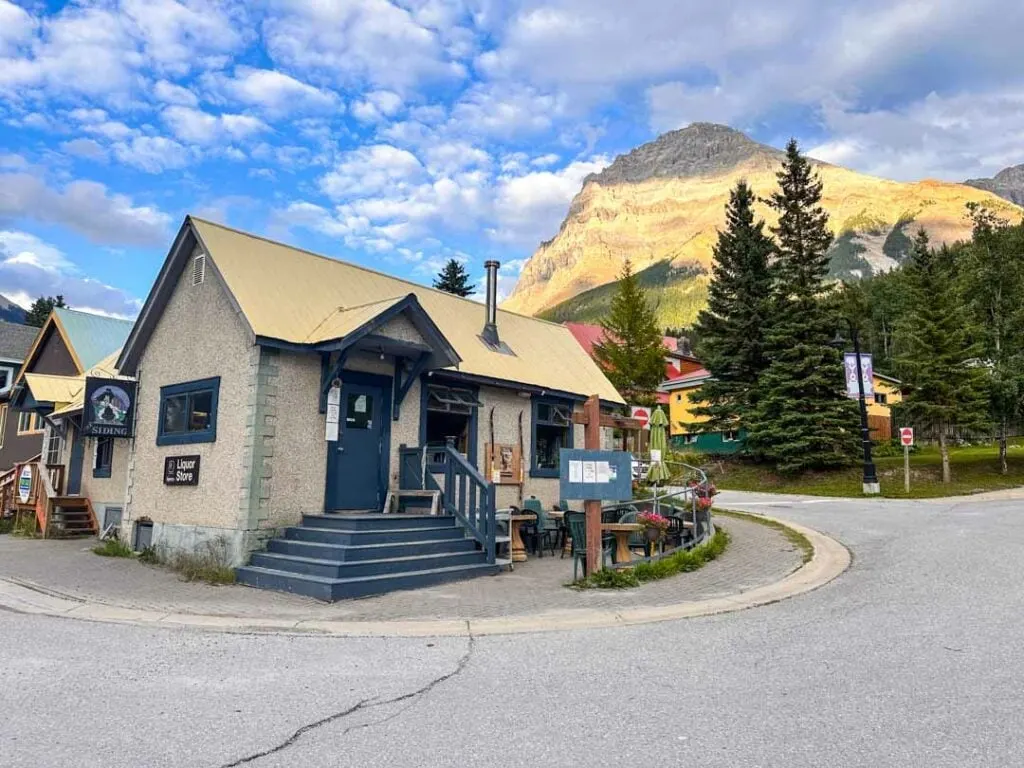
Spiral Tunnels
I’m not into trains, but I still found the engineering behind the Spiral Tunnels really interesting. Building a railway across Canada was a condition of BC joining Canada. However, getting through the Rocky Mountains was really challenging for trains due to the steep terrain.
The first tracks through Kicking Horse Pass in Yoho National Park were so steep that the first train to try it in 1884 derailed, killing three people. Instead, the railway engineers used a Swiss solution – they drilled two spiral-shaped tunnels, one into the rocks of Mount Ogden and another into Cathedral Mountain.
There are two places to see the Spiral Tunnels in Yoho National Park. The easiest one is the Upper Spiral Tunnel Viewpoint on Highway 1. If you time it right, you can see both the front and back ends of a train as it goes through the tunnel. It also has lots of info boards.
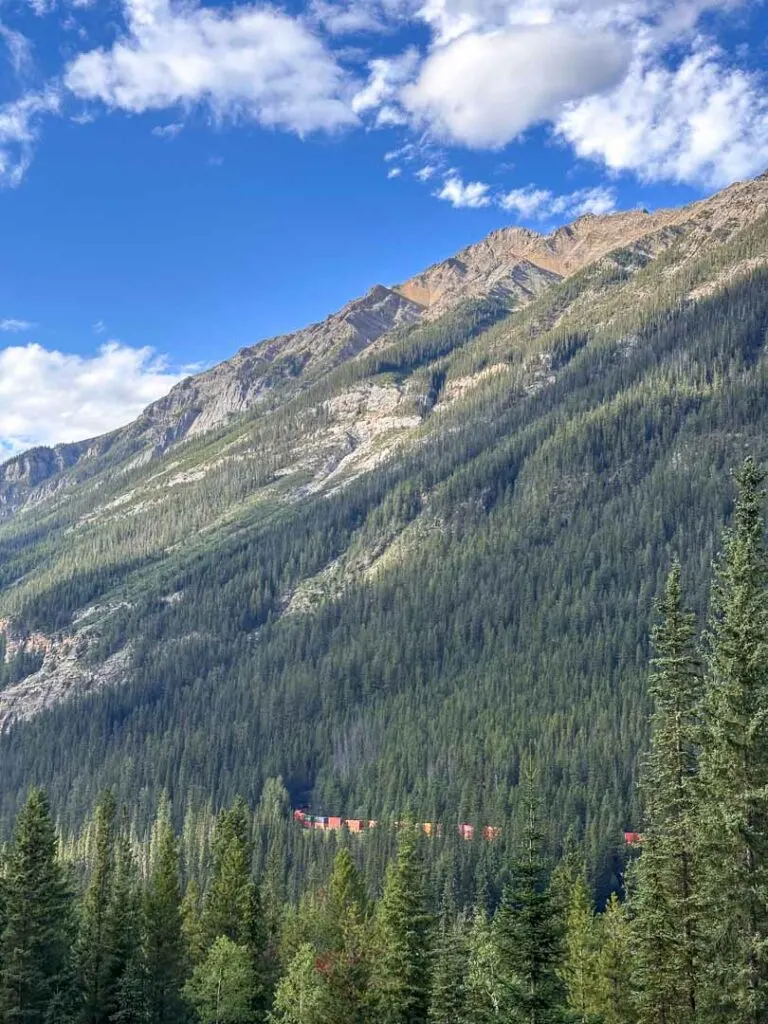
You can also see the tunnels from the Lower Spiral Tunnel viewpoint in the first few minutes of the drive up the Yoho Valley Road.
It can be hard to picture how the spiral tunnels work. Thankfully, there are scale models of the tunnels at the Upper Spiral Tunnels Viewpoint and at the Yoho Visitor Centre. The one at the Visitor Centre has model trains that run!
Iceline Trail
If you’re a hiker, you can’t miss the Iceline Trail. It’s the most spectacular trail in Yoho National Park. The path climbs steeply through the forest on switchbacks with views of Takakkaw Falls across the valley. Then it emerges from the trees and the views begin.
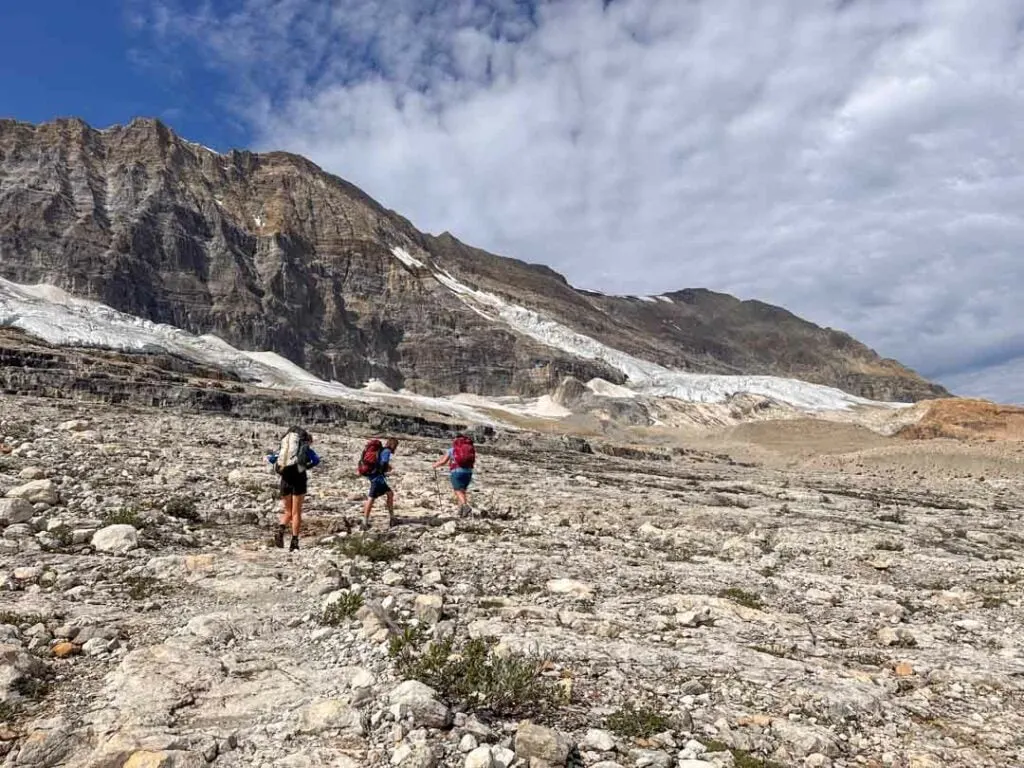
The hike starts at the Takakkaw Falls parking lot on Yoho Valley Road. You’ll walk through rocks and past turquoise ponds as glaciers hang from the slopes above and you gaze at the peaks across the Yoho Valley. There are lots of great viewpoints to stop and take photos.
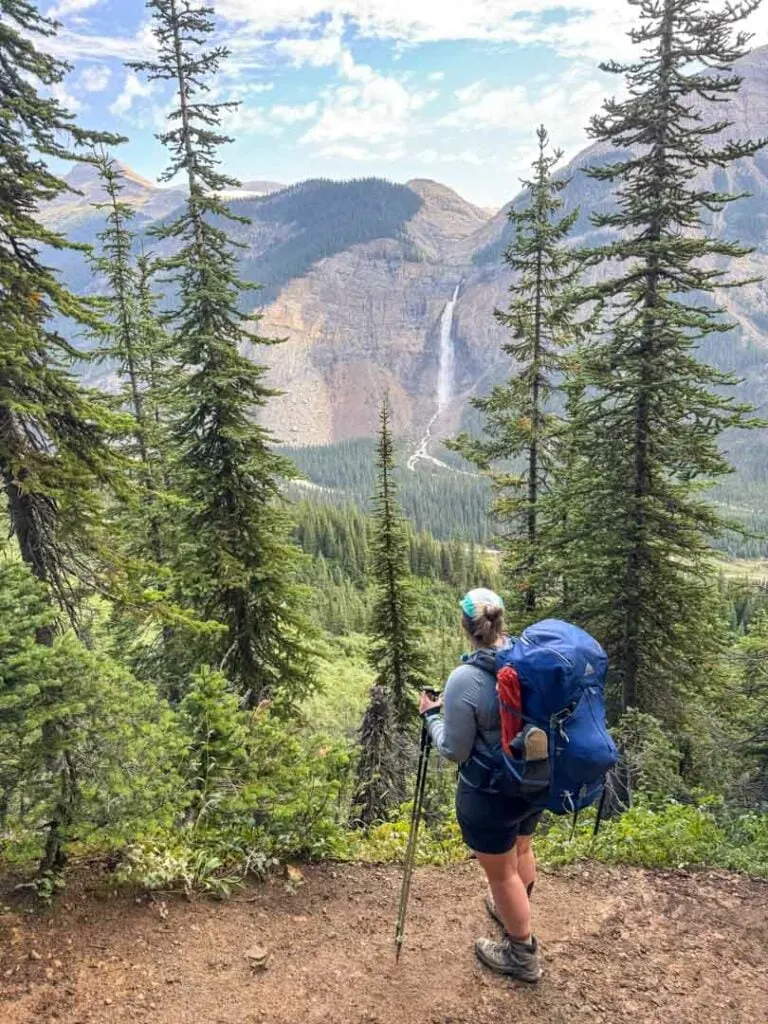
There are several ways to hike the Iceline. Most people do it as a loop via the Little Yoho Valley (20.8 km) or via Celeste Lake (17.5 km). You can also do it as an out-and-back hike to the trail’s high point (15 km). All options have 700 to 800 m of elevation gain. Expect the hike to take all day.
Another option is to include the Iceline Trail in a longer backpacking trip. That way you only can take your time and enjoy the Iceline since you’ll only have to hike 11.4 km from Takakkaw Falls to your campsite in the Little Yoho Valley.
I hiked the Iceline as part of the Yoho Valley Loop, a spectacular backpacking trip that also includes the other highlights in this part of the park like Laughing Falls, Twin Falls, and the Whaleback Trail. (More about those below.)
Laughing Falls
If you want an easy day hike in the Yoho Valley, head to 30-metre-high Laughing Falls. The 7.8-kilometre round-trip is fairly flat – it gains just 125 metres. The trail follows the Yoho River and passes two other waterfalls along the way. Allow two to three hours for the hike.

Twin Falls
Twin Falls is another great hike in the Yoho Valley. The two ribbons of the falls plunge 120 metres down the cliffs. If you are exploring around the base, put on your rain jacket – there is a lot of spray!
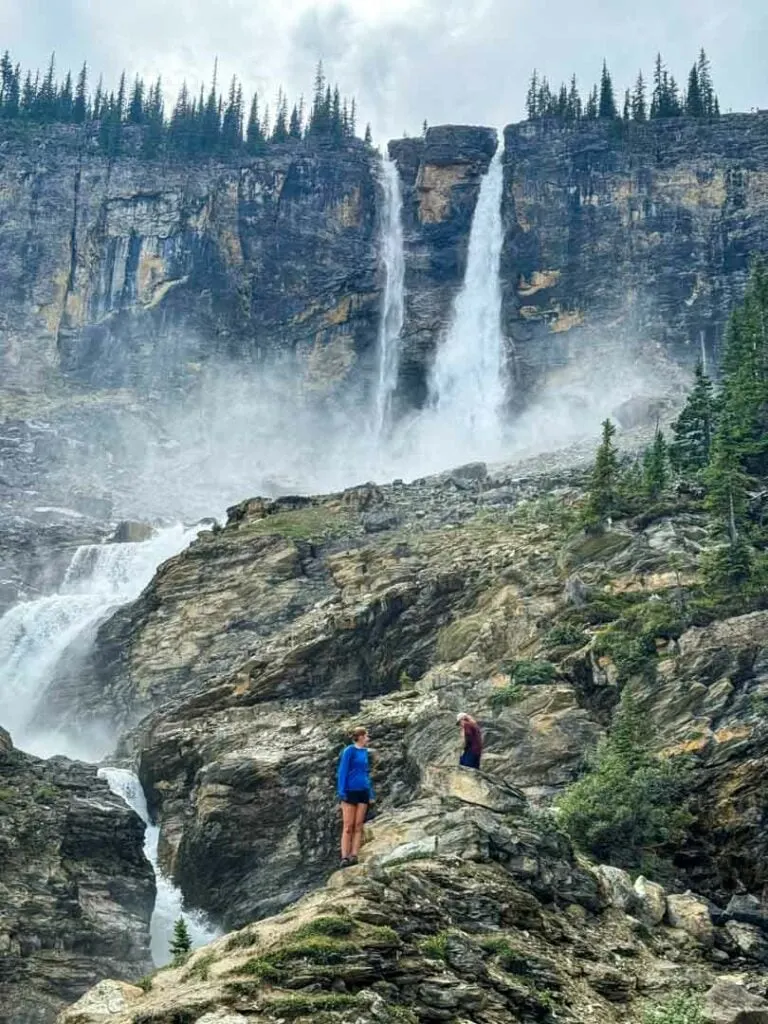
It’s also worth visiting the Twin Falls Chalet nearby. There is a great view of the falls from the front porch. This historic building dates back to 1923 and used to serve tea and meals to hikers. It’s been closed since 2019, but it may reopen since the Alpine Club of Canada now has a license to run it.

To get to Twin Falls, you continue along the Yoho Valley Trail from Laughing Falls. It’s a 16.4 km round-trip hike to the falls from Takakkaw Falls parking lot with 300 m of elevation gain. Allow 4 to 6 hours.
Whaleback Trail
While it doesn’t get as much buzz as other hikes in the Yoho Valley, the Whaleback Trail takes in some incredible scenery. The trail climbs steeply high above the valley floor over the shoulder of Whaleback Mountain. Next, it descends past the top of Twin Falls before plunging down to the bottom of the falls on a set of steep switchbacks.

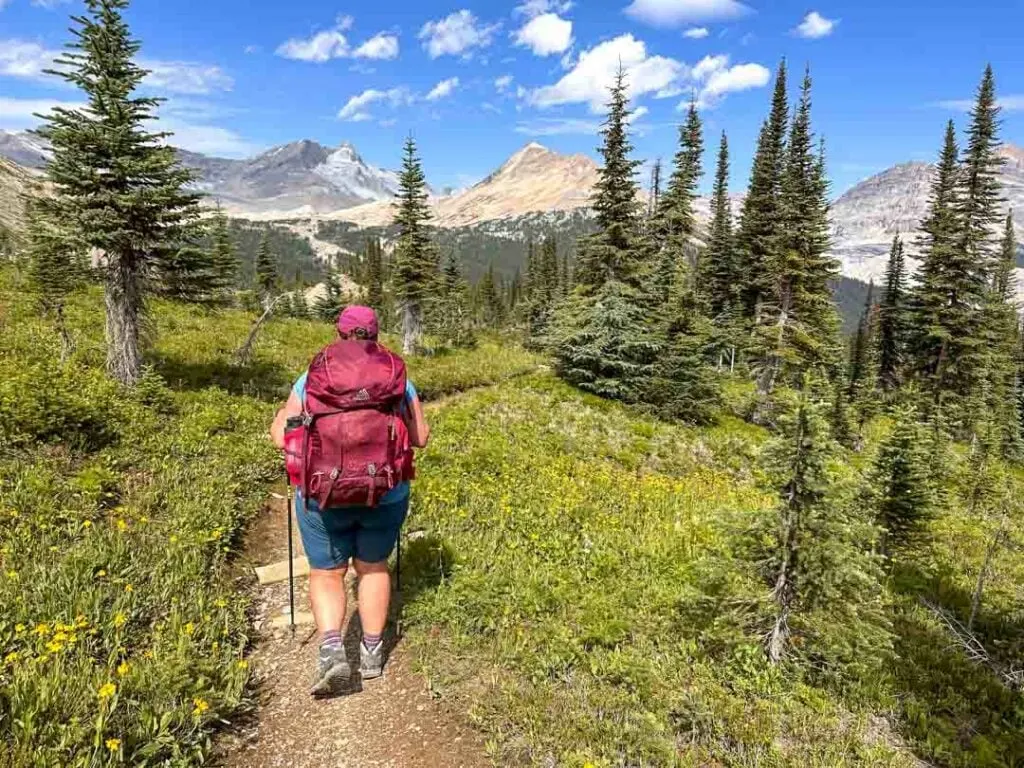
You can hike the Whaleback Trail as a 21.3 km loop from the Takakkaw Falls parking lot. This route includes 520 m of elevation gain and takes about 7 hours. You can also visit the Whaleback Trail as part of a backpacking trip in the Yoho Valley.
Sherbrooke Lake
The moderate hike to Sherbrooke Lake is a good option if you have more time in the park and want to explore outside the Yoho Valley and Emerald Lake areas. The 6.2 km round trip hike gains just 165 m and ends at a beautiful turquoise glacier lake with Mount Ogden towering overhead.

The hike takes about 2 hours, but I recommend combining it with Paget Lookout (below) since they share the same trailhead. The two trails split apart at a fork about 1.5 km from the parking lot. If you combine both Sherbrooke Lake and Paget Lookout, the total distance is 11 km with 695 m of elevation gain. The combined hike takes 3.5 to 5 hours.
Paget Lookout and Paget Peak
Paget Lookout is an old fire lookout with an incredible view of the mountains in the Kicking Horse Valley and the Great Divide. For decades, a fire watcher would live here each summer, trying to spot forest fires. These days the lookout is preserved as a historical structure.
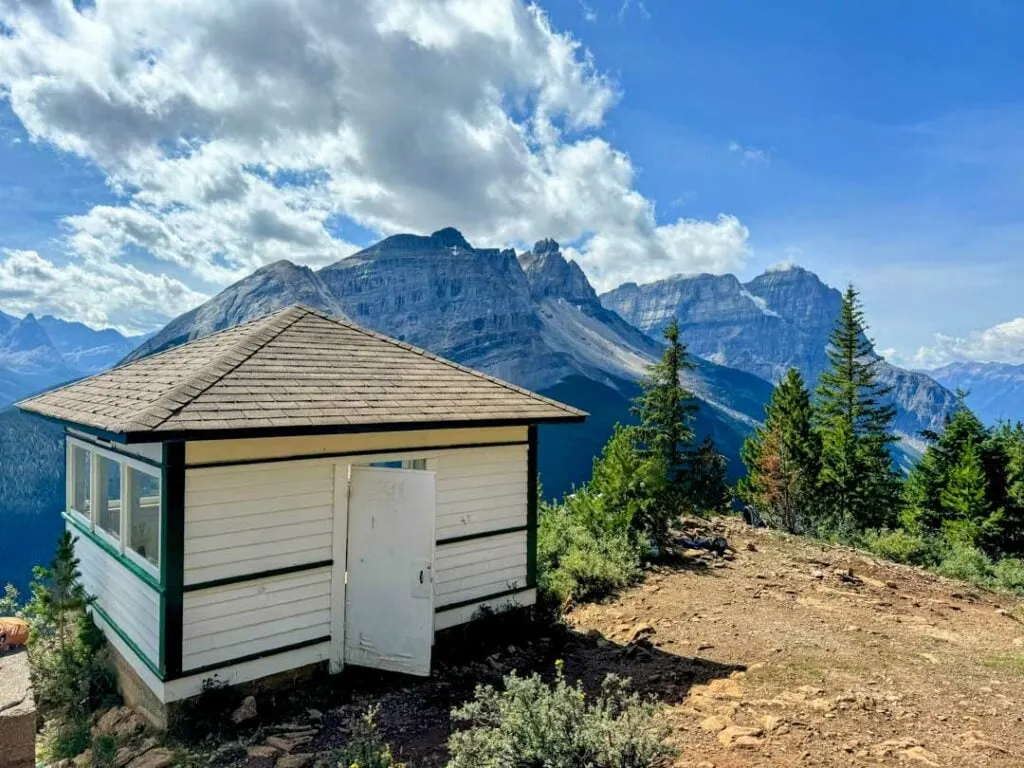
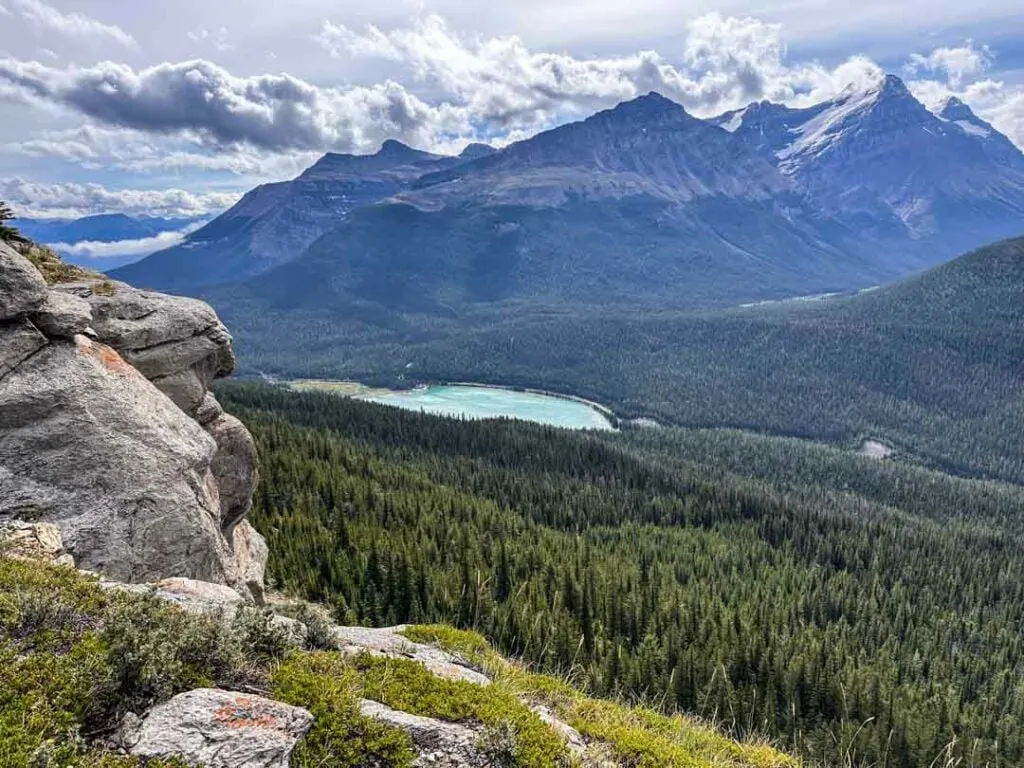
The hike to the lookout is steep, but only moderately challenging thanks to lots of well-graded switchbacks. It’s 7 km round-trip with 520 m of elevation gain and takes 2.5 to 3 hours.
The official trail ends at the lookout, but you can continue to the summit of Paget Peak via an informal scramble route. The route to the summit is 9.5 km long with 960 m of elevation gain. It takes 4 to 6 hours.
The scramble route is not technical – it is mostly walking on rock slabs and scree. There are a few cairns to mark the route, but for the most part, you will have to find your own way to the top.
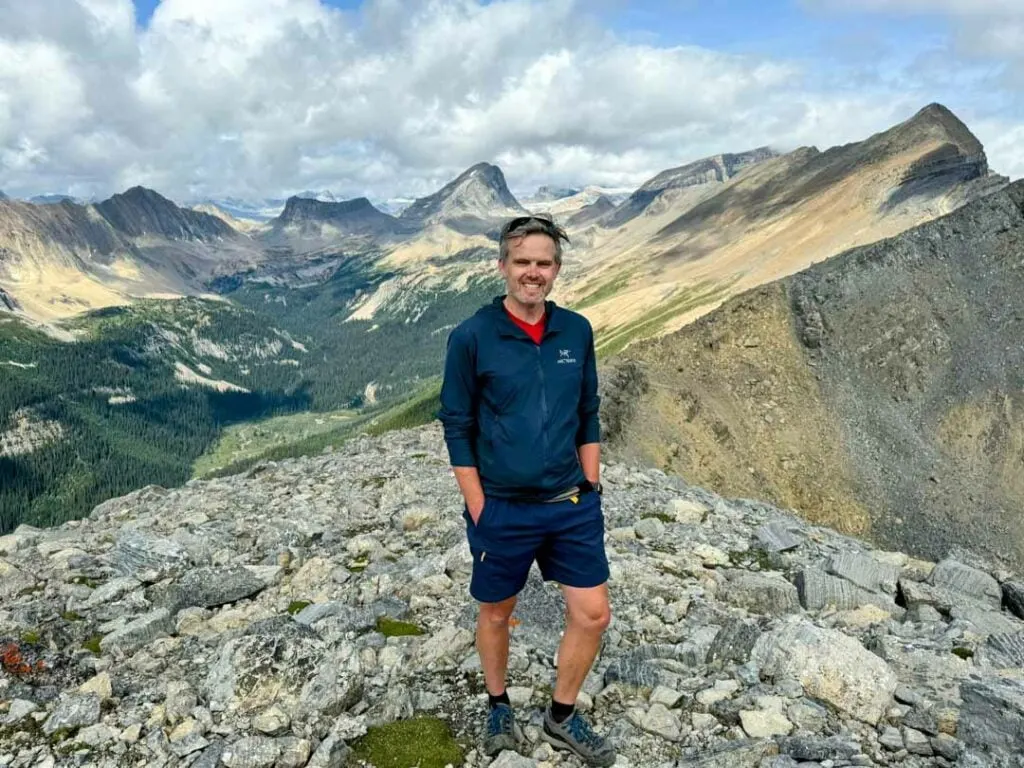

Wapta Falls
Wapta Falls on the Kicking Horse River isn’t that tall at only 30 metres high, but it is very wide – it’s over 100 metres from side to side. The falls are on the less visited western side of the park 26 km west of Field, so it can be a bit quieter here.
It’s a 4.6 km round-trip hike to the falls with 30 metres of elevation gain. Plan to spend about 1.5 hours on the hike.

Backcountry Camping
Going backcountry camping is my favourite thing to do in Yoho National Park. The two main places to do it are at Lake O’Hara and in the Yoho Valley. The two experiences are polar opposites.
At Lake O’Hara, you take a shuttle bus into a well-equipped campground with kitchen shelters, running water, a communal fire pit, and a washroom building with pit toilets. From the campground, you can take day hikes around the lake or to spectacular viewpoints. As far as backcountry camping goes, it’s pretty luxurious.
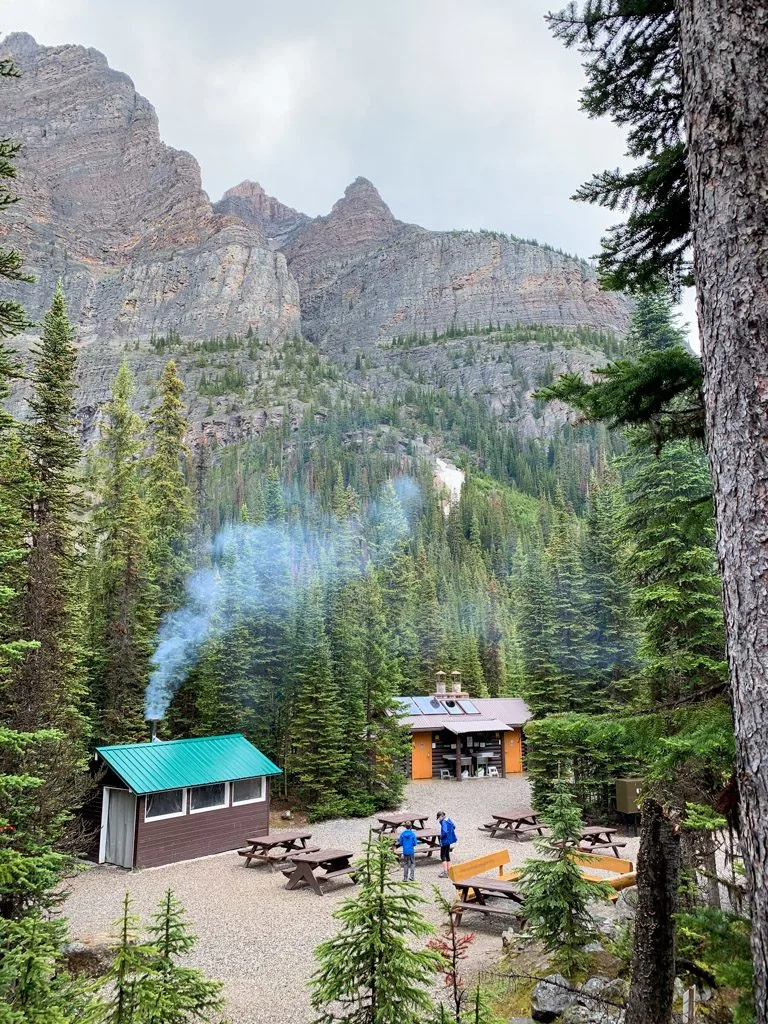
In the Yoho Valley, you can hike into four backcountry campgrounds: Laughing Falls, Twin Falls, Little Yoho Valley, and Twin Falls. The hike to Laughing Falls is fairly easy, but the rest are moderate to difficult. From the campgrounds, you can do spectacular hikes like the Iceline, Whaleback, and Twin Falls.
You can also combine several of the campgrounds to complete the Yoho Valley Loop. I hiked this route on my last trip to Yoho and I was blown away by the views around every corner.
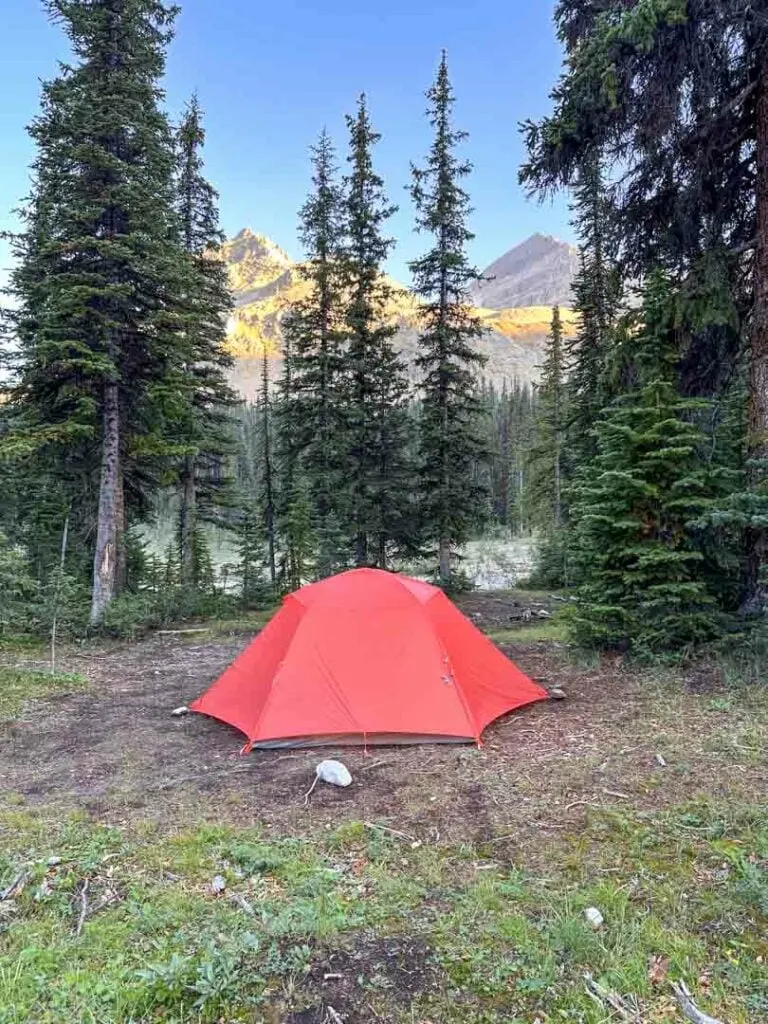
Where to Stay in Yoho National Park
Compared to nearby Banff, there aren’t that many places to stay in Yoho National Park. However, it’s worth spending a night or two in the park so that you don’t have to commute an hour each way from Banff.
Yoho National Park Hotels
Charlie’s Guest House: One of the many guesthouses in the town of Field, Charlie’s has suites with kitchens, gets great reviews, and is half a block from Truffle Pig’s Bistro. Check rates.
Cathedral Mountain Lodge: This luxury lodge on the Kicking Horse River near Field has log cabins with fireplaces. The main lodge building has incredible views and a high-end dining room. Check rates.
Emerald Lake Lodge: A classic Rocky Mountain hotel with huge stone fireplaces and cabin-style buildings. It’s a great place to stay to get Emerald Lake to yourself in the mornings and evenings. Check rates.
Whiskey Jack Hostel: Located near Takakkaw Falls, this basic hostel is a great place to stay if you are on a budget. Unfortunately, it is currently closed for repairs.
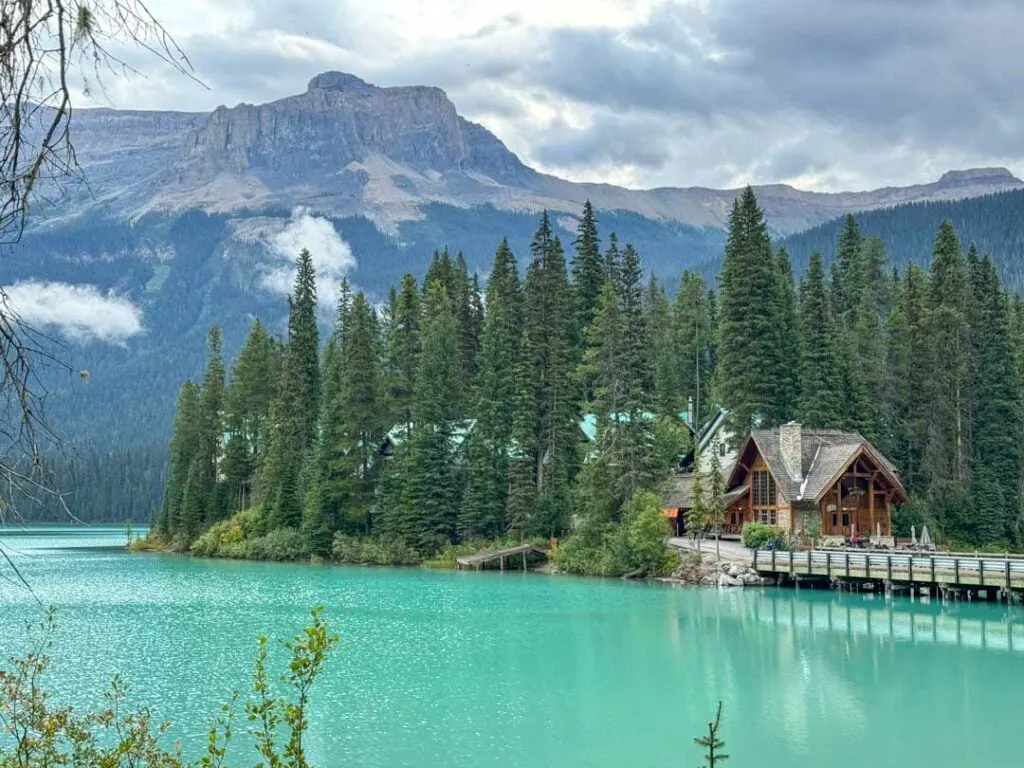
Camping in Yoho National Park
Yoho National Park has four campgrounds. Two of them (Kicking Horse and Takakkaw) require reservations. Reservations open in late January and early February and book up fast.
However, cancellations are common so you might be able to get a last-minute site. I recommend using a cancellation app like Campnab or Schnerp to notify you when cancellations come up. I was able to score nights at both Kicking Horse and Takakkaw Falls that way on my recent trip. My guide to camping cancellation apps has more details on how it works.
Reservable Campgrounds
Kicking Horse Campground: This is Yoho’s most popular campground. It has 88 sites and has flush toilets and showers. It has a great location at the start of Yoho Valley Road but it can be a bit noisy from the nearby highway and train. Check availability.
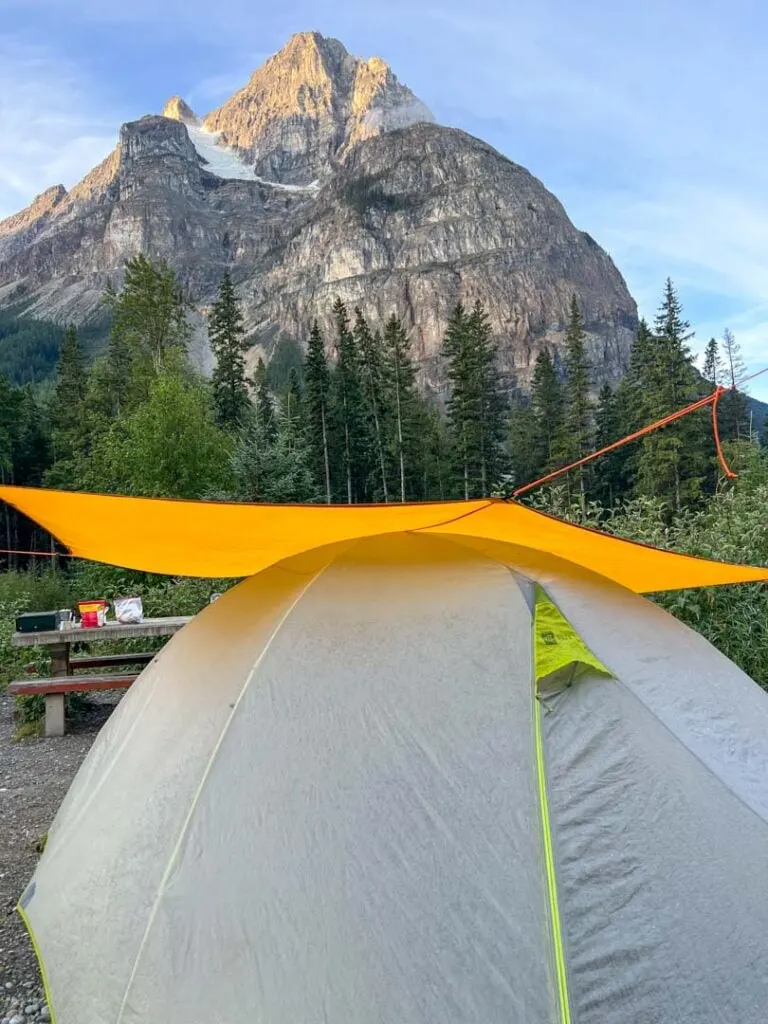
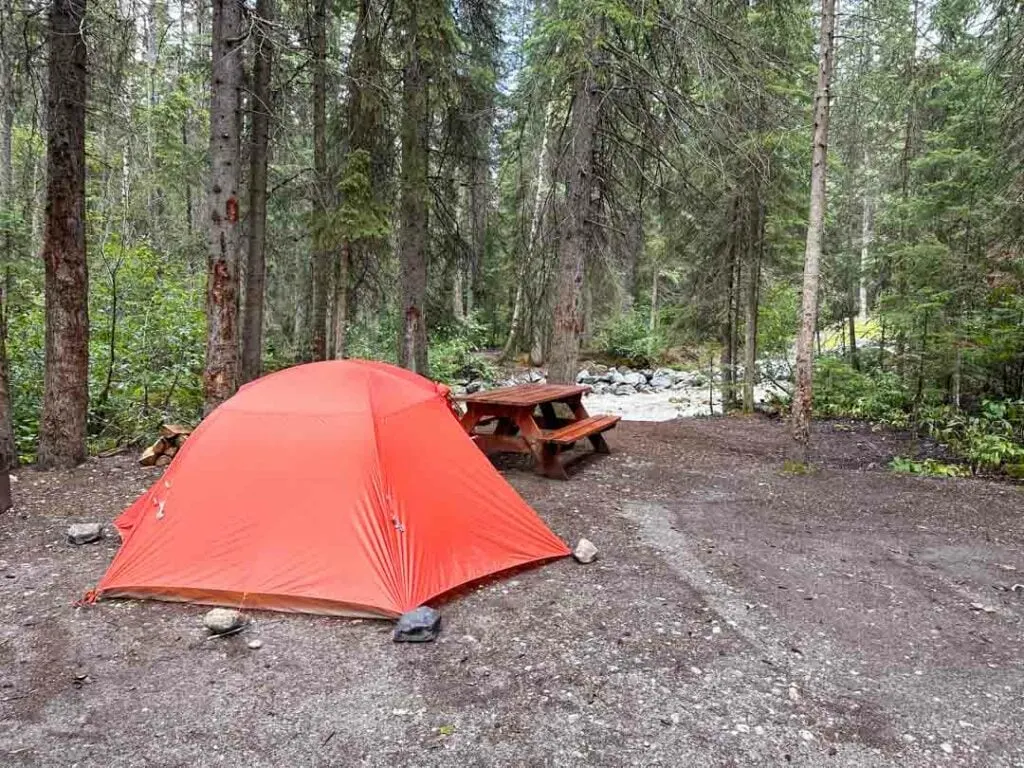
Takakkaw Falls Campground: This is a walk-in campground with 44 small sites, but an incredible location at the base of Takakkaw Falls at the end of Yoho Valley Road. It’s a 5 to 10-minute walk from the parking lot and there are wheelbarrows to help carry your gear. The campground has running water, pit toilets, and animal-proof storage for your food. Check availability.
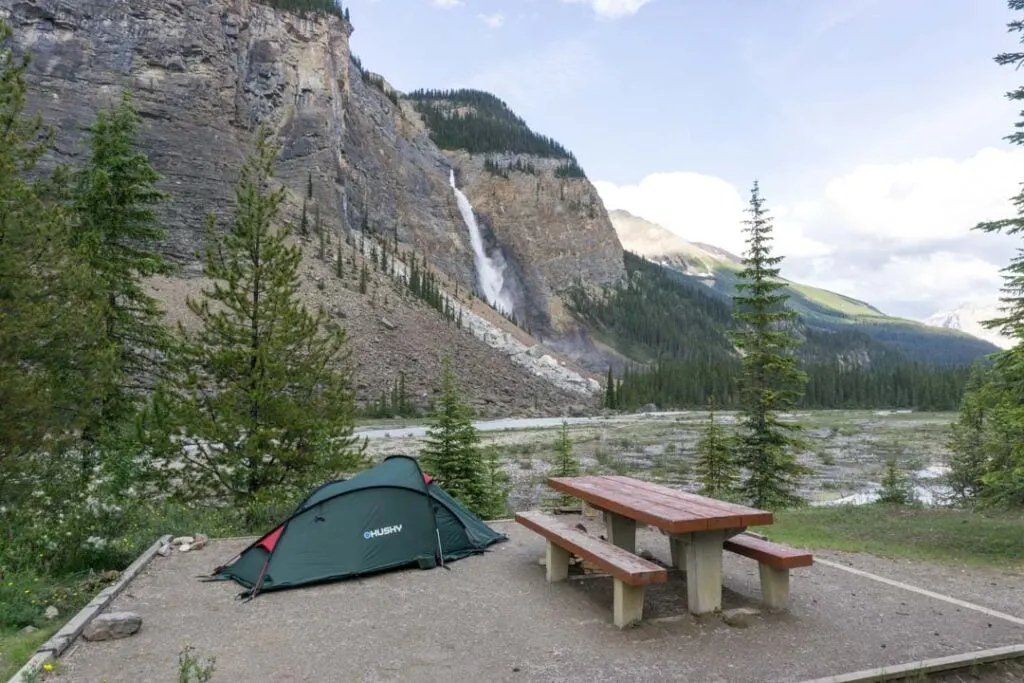
First-Come, First-Served Campgrounds
Monarch Campground: Since this 35-site campground is first-come, first-served, it’s good for last-minute trips – but you’ll need to arrive early in the day to get a spot. Monarch is next to Kicking Horse Campground on Yoho Valley Road, but it does get a lot of highway noise. It has running water and pit toilets.
Hoodoo Creek Campground: Find this campground in the quiet western part of the park. It’s close to Wapta Falls but about 20 minutes from Field. The 30 sites here are first-come, first-served and have pit toilets. You need to bring your own water.
Final Thoughts
Yoho National Park is a bit under the radar compared to Banff, its more famous next-door neighbour. But I find myself returning to Yoho over and over for the spectacular scenery, interesting history, and less crowded trails.
If you’re planning to visit the Canadian Rockies, you can’t miss Yoho. You might be tempted to do it as a day trip from Banff. But I think you’ll find so many things to do in Yoho National Park that it’s worth spending two or three days here.
If you have questions about visiting Yoho National Park, ask them in the comments and I’ll help you out.
READ NEXT:
- 2024 Lake O’Hara Camping and Hiking Guide (Yoho National Park)
- Backpacking the Yoho Valley Loop/Iceline Trail
- How to Take an Epic Canadian National Parks Road Trip
- Best Things to Do in Banff in the Spring
- 9 Beautiful Reasons to Visit Banff in the Fall
- The Best (and Worst) Backpacking Meals Reviewed - December 16, 2025
- My Favourite Hiking Gear of 2025 - December 9, 2025
- Best Insulated Skirts For Hiking and Snowshoeing in 2026 - December 5, 2025

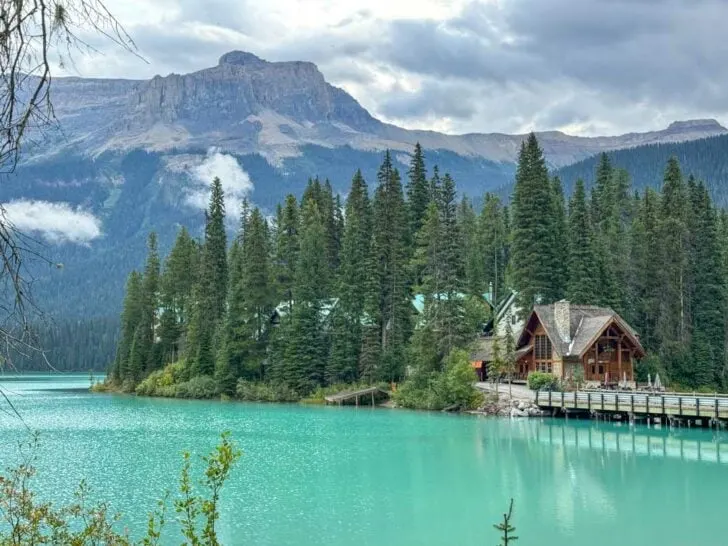
Xenia
Saturday 1st of February 2025
Thanks for sharing all of this!! That's so amazing and I'm getting so excited for my trip!!!!